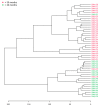NMR-Based Metabolomics Demonstrates a Metabolic Change during Early Developmental Stages from Healthy Infants to Young Children
- PMID: 36984885
- PMCID: PMC10058828
- DOI: 10.3390/metabo13030445
NMR-Based Metabolomics Demonstrates a Metabolic Change during Early Developmental Stages from Healthy Infants to Young Children
Abstract
The present study aims to identify the salivary metabolic profile of healthy infants and young children, and to correlate this with age, salivary gland maturation, and dentition. Forty-eight children were selected after clinical evaluation in which all intraoral structures were examined. Total unstimulated saliva was collected, and salivary metabolites were analyzed by 1H Nuclear Magnetic Resonance (NMR) at 25 °C. Partial least squares discriminant analysis (PLS-DA), orthogonal PLS-DA (O-PLS-DA), and univariate analysis were used, adopting a 95% confidence interval. The study showed a distinct salivary metabolomic profile related to age and developmental phase. The saliva of children in the pre-eruption teeth period showed a different metabolite profile than that of children after the eruption. However, more evident changes were observed in the saliva profile of children older than 30 months. Alanine, choline, ethanol, lactate, and sugar region were found in higher levels in the saliva of patients before 30 months old. Acetate, N-acetyl sugar, butyrate, caproate, creatinine, leucine, phenylalanine, propionate, valine, succinate, and valerate were found to be more abundant in the saliva of children after 30 months old. The saliva profile is a result of changes in age and dental eruption, and these findings can be useful for monitoring the physiological changes that occur in infancy.
Keywords: children; infant; metabolites; metabolome; nuclear magnetic resonance; saliva.
Conflict of interest statement
The authors declare no conflict of interest.
Figures





Similar articles
-
Untargeted stimulated and unstimulated salivary metabolomics and saliva flow rate in children.Clin Oral Investig. 2024 Aug 17;28(9):489. doi: 10.1007/s00784-024-05883-0. Clin Oral Investig. 2024. PMID: 39153029
-
Salivary metabolome of children and adolescents under peritoneal dialysis.Clin Oral Investig. 2021 Apr;25(4):2345-2351. doi: 10.1007/s00784-020-03557-1. Epub 2020 Sep 2. Clin Oral Investig. 2021. PMID: 32880015
-
Salivary metabolomic profile in adolescents with juvenile systemic lupus erythematosus.Braz Oral Res. 2022 Nov 11;36:e0128. doi: 10.1590/1807-3107bor-2022.vol36.0128. eCollection 2022. Braz Oral Res. 2022. PMID: 36383834
-
Salivary Metabolite Fingerprint of Type 1 Diabetes in Young Children.J Proteome Res. 2016 Aug 5;15(8):2491-9. doi: 10.1021/acs.jproteome.6b00007. Epub 2016 Jul 5. J Proteome Res. 2016. PMID: 27306956
-
Saliva Metabolomic Profile in Dental Medicine Research: A Narrative Review.Metabolites. 2023 Mar 3;13(3):379. doi: 10.3390/metabo13030379. Metabolites. 2023. PMID: 36984819 Free PMC article. Review.
References
Grants and funding
LinkOut - more resources
Full Text Sources

